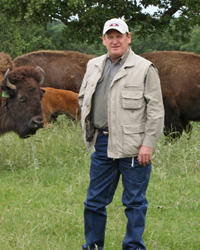Yellowstone National Park Bison Really Two Different Populations
The American Bison is an iconic species that conjures up visions of the wide-open prairies characteristic of the Wild West. The spirit of this amazing animal lives on at Yellowstone National Park, home to one of the few populations of bison known to have continually persisted on their current landscape since Pre-Columbian times.

The numbers of bison in the Yellowstone herd has fluctuated from less than 100 individuals to more than 3000, but even more amazing than the growing numbers are the genetic secrets these gentle giants continue to reveal about their past that will help to determine their future.
A recent study conducted by researchers at Texas A&M College of Veterinary Medicine & Biomedical Sciences (CVM) and their collaborators presented in the most recent issue of the Journal of Heredity has highlighted the use of modern biotechnology to better understand the natural forces that influence wildlife populations.
“In the course of conducting conservation genetics studies of the Yellowstone herd, we discovered that the herd is really separated into two distinct subpopulations,” said James Derr, professor in the veterinary pathobiology department at the CVM. “These two subpopulations have shown genetic differentiation usually seen in populations that have been geographically separated for more than 40 years. In addition, we were also able to identify critical differences in migration patterns between the two subpopulations.”
The improved ability to study the genetics of animals in the wild through advances in technology is crucial for wildlife conservation efforts for any species. The environment plays a significant role in the nutrition, reproduction habits, and genetic diversity within a species – all of which can determine the successful survival of that species.
“The technology available today allows us to discover previously unknown, but crucially important factors, such as cryptic population subdivision,” said Natalie Halbert, collaborator on the study. “Knowledge this detailed provides the opportunity for us to better manage our natural resources and ensure effective stewardship of these resources for long term species conservation.”
From the beginning of the study, the research team planned to document genetic diversity, migration histories and genetic integrity of the bison in this important national herd.
“Finding two genetically distinct Yellowstone bison subpopulations was unexpected,” said Peter Gogan, United States Geological Survey. “But the findings are consistent with what we have learned about the location of the bison subpopulations during the rut and other components of bison demographics including differences in tooth wear, timing of calving, and even survival and reproductive rates. All of this information seems to indicate that these two bison subpopulations have existed for quite some time, possibly back to the reestablishment of this herd in the early 1900s.”
This new information that there are two genetically distinct populations coexisting geographically in Yellowstone, provides an important tool in assisting future population management of this herd and for ensuring the continued success of the American Bison.


